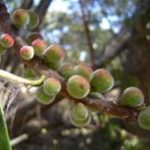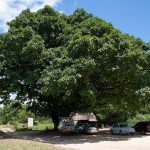TREE LIFE
March 1982
MASHONALAND CALENDAR
Tuesday March 2nd : Botanic Garden walk. Meet at the Car Park at 1645 for 1700 hours.
Sunday March 21st : Airport Road. On the Airport Road just before Hatfield there is a lovely patch of “bush” with a wealth of trees. It is unbelievable when in there that one is so close to town, the traffic on the road is just a distant sound and the world passes remotely by. This is what we shall explore on this occasion. Come for the morning or make a day of it.
Saturday March 13th : Learner group. There will be a meeting at the Coronation Park Caravan Park at 0930 hours. All welcome. Please contact Mrs. Gill Masterson – telephone 303455 between 0600 – 0630 hours or in the evening.
BOTANIC GARDEN WALK 2ND FEBRUARY 1982
Cheryl Haxen was with the other 25 members and friends who were present on this occasion and this is her report :
Having been rained out last month, we gathered with some trepidation once more at the gardens. However, the weather held, and we were able to at last look at some of Zimbabwe’s less common trees, courtesy of Tom Muller.
Tom led us a most active (both energetically and mentally) walk and we examined over 30 species.
We began with 2 rare figs, MORACEAE. Ficus bubu is restricted to the Haroni Rusitu forest. With its very large leaves and yellow trunk, it should be unmistakable. Ficus vallis-choudae is another forest species, as for the above species restricted to a small eastern area of the country. It has triangular leaves, but the rough bark and buttressed trunk are unusual for a fig, and most distinctive.
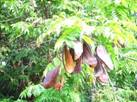
Erythrophleum suaveolens. Photo: Mike Bingham. Source: Flora of Zimbabwe
Erythrophleum suaveolens, CAESALPINIOIDEAE, is the “forest ordeal tree”. The ‘ordeal’ ceremony is described in Coates Palgrave, but suffice to say that a toxin causing gastro-intestinal irritation and heart failure has been isolated from bark and roots. Zanthoxylum trijugum (formerly Fagara trijuga) is a genus of RUTACEAE, the citrus family. There are some 16 different species belonging to this family in Zimbabwe, and most, if not all, are aromatic with scattered or marginal translucent glands on the leaves. Simply by crushing a leaf, one can identify the family. Z. trijuga has a very limited distribution and its ecology is largely unknown.
Terminalia trichopoda, COMBRETACEAE, is not a rare tree, but it was pointed out to us as having being the only riverine Terminalia, and as being the smoothest barked species occurring in Zimbabwe.
Two highly drought-adapted species from our Southern Lowveld were of interest. Sesamothamnus lugardii, the “sesame bush”, PEDALIACEAE, resembles a bonsai baobab in general appearance but has its branches armed with numerous spines. Catophractes alexandri occurs in the same area as Sesamothamnus and is superficially similar. However, it belongs to the jacaranda family, BIGNONIACEAE.
Euphorbia halipedicola is probably the rarest euphorbia in this country. It occurs on anthills in Mozambique, but there is only one record for Zimbabwe, from the Sabi Valley. However, there is a thriving specimen in the gardens.
Spirostachys africana, the ‘tamboti’, EUPHORBIACEAE, occurs in low altitude bush of our Southern Lowveld. It is a tree much valued for its timber, which is exceptionally durable, and from which fine furniture is made. However, the sap is very toxic, and even sawdust from the timbers can cause poisoning. The wood is hard to come by, as the tree is seldom common, and the trunks are almost never straight or unmarked.
One account I read, of a family whose entire livelihood depended on making tamboti furniture, described how the trunks were left to lie for about 8 years, to season before being sawn, and even then the family wore masks as protection against the sawdust. However, a finished table or desk would then sell for upwards of R1000.
It is well to finish off with Dovyalis hispidula, FLACOURTIACEAE, the ‘bristly dovyalis’ since it was most memorable due to it being in heavy spectacular, and edible, fruit. Tom, as usual led the way to savouring the bright red fruits, not really recommended for those with a sweet palate. Dovyalis hispidula is confined to the South east Lowveld of Zimbabwe.
-Cheryl Haxen
VISIT TO NKODZWI FARM 21ST FEBRUARY 1982
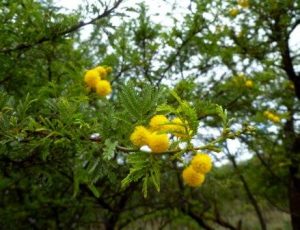
Acacia karroo. Photo: Paul Hubbard. Source: Flora of Zimbabwe
Sunday dawned cloudy but at least it was not raining as it had been at the dawn of the previous day. Nevertheless, we had a full complement of 36 on the bus as it set off on the Lomagundi road, heading towards Raffingora. After we had crossed the Great Dyke we found that beautiful grove of Acacia karroo, the sweet thorn, in lovely yellow flower. I am tempted to say still in flower, as when I went to Kariba on 30th November last year, they were in such magnificent flower that we smelled their perfume as we passed. Those who had their bus windows open on this occasion were able to also enjoy the perfume. Whether one smelled them or merely enjoyed their bright yellow splash they metaphorically started the sunshine of the day. The bus made such good time that we rather embarrassed our hosts, the Ayrshire Branch in general and John and Anne Duffield. of Nkodzwi Farm, in particular, by arriving earlier than expected and while tea was being prepared, we either strolled about the lawn admiring the view and surroundings or discussed an enormous Combretum in their garden. The first fruit we found was deceptive and it was only after binoculars had been brought into use and another fruit was seen that we eventually decided that it was the large-fruited Combretum, Combretum zeyheri. The leaves are described as opposite or three whorled and that agrees with what we saw. The variable Combretum, Combretum collinum, which was our earlier guess, has leaves which are opposite or alternate, or occasionally can be in whorls.
And then tea was served and I did not notice anyone saying that there were so many trees to see that there was no time for tea! It was a magnificent spread and a big thank you to you Ann, and your helpers. We really enjoyed it.
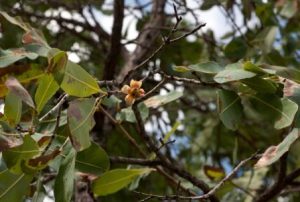
Ochna gambleoides. Photo: Bart Wursten. Source: Flora of Zimbabwe
We boarded the bus and went back to those lovely granite kopjes we had passed just before turning onto the farm homestead road. Everyone was delighted at this choice of venue and at the foot of the kopjes we found one of the most exciting discoveries of the day, which we did not realise at the time; this was a large-leaved Ochna, Ochna gambleoides, that slender tree with large, tough blue-green leaves with very distinctive yellow midribs and petioles, which reminded some of a Protea. The first one we saw was at the beginning of the climb to the rock paintings. We did not know it at all and only subsequent identification at the herbarium has given us its name. Had Mrs. Gill Masterson been there she would have recognised it because it has been seen previously by the Society at Trianda Farm in June, 1979, when Gill described it as a “rare tree previously collected from the Urungwe district, on the Sipilolo Zambesi escarpment and more recently from near Bindura”. On Sunday we saw it not commonly but certainly on more than one occasion. Had it been in flower or fruit we would have had no difficulty in recognising it as they appear, from descriptions, to be characteristic of an Ochna. Although the fruiting time is October to March, there was none to be seen.
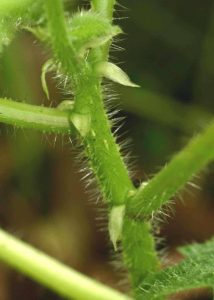
Obetia tenax. Photo: Mark Hyde. Source: Flora of Zimbabwe
Those of us who had dallied or become absorbed and delayed the dash up the kopje were warned by those coming down to beware as there was a Tree Nettle up there. This was Urera tenax, a fascinating tree with surprisingly little written about it in the literature. All parts; leaves, flowers, fruits, stems and even the main trunk are covered with the formidable whitish stinging hairs. Anyone encountering them would find it interesting indeed and could experience an intense burning pain and even blistering of the skin. It belongs to the nettle family URTICACEAE and deviations are interesting ‘urtica’ is the Latin name for nettle (from which we also get the word urticarial meaning a nettle like rash); ‘urens’ means stinging and ‘tennax’ means tenacious.
Another common species of this family that we saw was Pouzolzia hypoleuca, snuggle leaf, called this because the leaves can stick together, the under surface of one to the upper surface of another and, as children we had great fun making cups, bowls and hats from them. The leaves are quite beautiful, being dark green and rather rough above and silvery white felted below. It has no stinging hairs at all even though it belongs to the nettle family. One of it common names the Soap-brush is very apt because the under bark is slimy and is used as a lubricant and Mrs. Dickie Graves of Ayrshire Branch cleans her sticky hands with the leaves after picking Carissa edulis fruit for making jelly. Derivations again: Pouzolzia after Pierre Marie de Pouzolz and much more interesting, hypoleuca ‘hypo’ meaning below and ‘leuca’ white. What better description to give the leaves.
The Tree Nettle we passed as we clambered up the dwala to the paintings was smallish and fortunately easily avoidable. However, there was a lovely big one, a proper tree with its pale pinkish stem safely out of the way in a gap between two rocks. The pride of that place was an overhanging Commiphora marlothii, paper bark Commiphora, with its lovely green stem peeling large yellow papery flakes. Some of the fruit was ripe and, when squeezed, spit open into two sections to reveal the small dark hard seed with a red covering clasping it up each side. This is called a pseudaril and most of our Commiphora seeds have one which can be either red or yellow, and have either 2 or 4 arms.
Also in fruit, but green, was Erythroxylum emarginatum. This we have found with its small inconspicuous white flowers, but I have not seen the fruit before. Of course, the emarginate leaf, i.e. with a little notch in the apex, was unmistakable.
Bridelia mollis, Velvet Bridelia, was another species which we do not often see. ‘Mollis’ means soft and aptly describes the soft velvety texture of the leaves. This specimen was in green fruit showing us that its fruit are also very velvety. Shortly afterwards we found a Bridelia cathartica, the knobby Bridelia, in flower and we were able to see how the flowers of today would be the fruit of tomorrow and the knobs of next year. The genus Bridelia is a member of the family EUPHORBIACEAE as is Margaritaria discoidea (synonym Phyllanthus discoideus) which was also in green fruit, a three-lobed capsule, characteristic of the euphorbia family. I am sure you must be familiar with the fruit of the Poinsettia or E. leucocephala, the Miniature White Poinsettia to know what I am talking about.
We frequently saw a small tree which we all agreed was a Vernonia and there were several suggestions as to which one it could be. Apparently they can be grouped into the V. bellinghamii/V. kreismannii group which have leaves with a silvery to densely white felt matt on their under surface and the V. amygdalina/V. colorata group which although their leaves have a paler under surface they are not densely silvery white. And then there is V. subuligera which has those conspicuous stipules. (It as called V. stipulacea). Although there are 113 Vernonias listed in the Flora Zambesiaca area the ones that I have mentioned are the only ones included in the National Tree List. The main feature which distinguishes V. colorata from V. amygdalina is that V. amygdalina has seeds with hairs and glands while those of V. colorata have only glands, and of course one needs a lens or a microscope to see this. Vegetatively V. colorata appears to have longer petioles, more hairy leaves with a more wavy margin. The one we saw was V. kreismannii. Its leaves were larger than 8 x 3.5cm with a slightly asymmetric base and finely toothed margins. V. bellinghamii has smaller leaves with a base that is usually tapering and the margins are usually entire or they can be slightly uneven.
There were four members of the Grape family, VITACEAE which were common. The creeper with digitate or 5-foliate brownish leaves was Ampelocissus obtusata. It had little bunches of grape-like fruit and we found some skins left by squirrels or birds which showed that they had also discovered the resemblance to grapes; Cissus welwitchii has simple leaves rather grape-like in shape and slightly fleshy looking and the green fruit were on long stalks. It is not common and has been collected previously at Muriel Mine. It has not been recorded east of the Dyke. Cissus cornifolia is a shrub described as widespread and frequent with reddish, squarish twigs and simple, slightly fleshy leaves. The fourth member of the grape family was the familiar Rhoicissus. I think it was R. tridentata which has leaves with teethier margins and not R. revoilii which has leaves with entire margins.
We proved a Mukwa without fruit to be a Mukwa, Pterocarpus angolensis, by gorging a hole in its trunk to make it bleed, and found an interesting Pterocarpus rotundifolius whose leaflets seemed to be wrong, so I brought back a specimen. This proved to be P. rotundifolius subsp. polyanthus which has longer leaflets, not as round as those of subsp. rotundifolius.
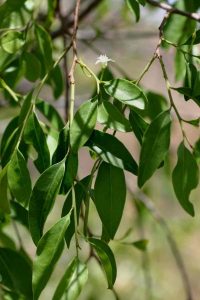
Olax obtusifolia. Photo: Bart Wursten. Source: Flora of Zimbabwe
After lunch we went to see the elephant rock paintings (I have not been able to find out anything about these paintings as I have not yet spoken to the right body at the Museum but hope to do so shortly). On our way there we found Olax dissitiflora. Unfortunately we did not realise that someone had collected Olax obtusifolia because then we would have been able to compare them in the field. The main difference is in the length of the petiole; that of O. obtusifolia being only up to 2mm while that of O. dissitiflora varies from 3mm to 8mm, still not very long but obviously a petiole. These are members of the family OLACACEAE as are the Ximenias of which we saw the furry brownish X. caffra, sour plum, and the glabrous bluey-green X. americana, although not in fruit they were completely distinguishable.
There was another species with a sticky leaf, the shrub with pink flowers, Pseudarthria hookeri, a member of the Legume family. Its common name is Bug-catcher and to quote from the Rhodesian Botanical Dictionary “A ring of branches placed round a sleeping person catches bedbugs; next morning the branches with the bugs are disposed of”. Several people wandered round with the leaves stuck to their clothes – no comment!
The very unusual little flower which was picked near the Elephant Paintings has been identified as Triaspis macrepteren, a creeper that I am sure everyone knows when it is in fruit which are four-winged rather like miniature papery combretum fruit. The flowers were most interesting. They appeared to have no petals because the petals are covered with long slender processes which give the impression that they are all antlers. Why? It was a most exciting to have seen them.
The unusual Ziziphus which we saw was Ziziphus mauritiana which is considered to be an introduced species that has become naturalised. It is widely distributed in the Middle East countries and has been cultivated in Mozambique for its edible fruits. It has spread up the Zambezi Valley in Zimbabwe and now is often found near roads or paths where people eating the fruits have cast away the seed. The fruits are used to make ‘kachaso’ a primitively distilled spirit of considerable potency and they are also reputed to make a very good quality gin. Ziziphus mauritiana has the paired stipular spines, characteristic of Ziziphus, one hooked and one straight, which catches you no matter which way you go and gives rise to the very good common name vag’n bietjie or Wait a bit thorn. The leaves are 3 veined from the base but in this species the bases are almost symmetric whereas those of Z. mucronata and Z. abyssinica are markedly asymmetric.
Then another lovely tea before boarding the bus and making tracks for home. We returned via Mtoroshonga which was a lovely scenic drive and the late afternoon sun shone and brightened the sadness of having to end such a beautiful day.
Thank you John and Anne Duffield for a memorable day and Mrs. Dickie Graves and the Ayrshire Branch for arranging it.
MATABELELAND BRANCH CALENDAR
Sunday March 7th : We are invited to Kloof Farm by Mrs. A. Visser to see Kalahari Sand type (and other) vegetation. The turning to the farm is 20km along the Nyamandhlovu /Road. Meet at City Hall Car Park at 0830 and bring lunch.
Sunday April 4th : To the inexhaustible area – Rhodes Matopos National Park. Meet at Retreat at 0830 hours. Bring lunch.
The meeting on Sunday, February 7th at the home of Val Deas when several members of the branch renewed their acquaintance with some of the thirty one species of indigenous trees on the property. After inspecting the health of Acacia gerrardii and Maerua angolensis and noting the progress of the stripling Erythrina transvaalensis (grown from seed), the party moved up Crouch Road, accompanied by an ecstatic Jock and Jess, and within minutes were deep in the Matsheumhlope wilderness. Civilisation has barely encroached on this unspoilt area, and the few new houses are generally so discreetly tucked away that we had to stumble on a mealie patch to be reminded that we were not in the heart of the bundu. A cool wind blowing strongly from the South tempered the summer heat, and the vigorous growth everywhere in evidence made one wonder when the effects of the current drought would be felt.
We followed bush paths almost to the television mast off Circular Drive before turning back. Some notable sights were the pink seeds on Terminalia sericea, a Flacourtia indica with especially rich foliage, an exceptionally large Turraea nilotica; and Erythrina latissima seeding generously and a Cassine matabelica growing gallantly despite extensive ring barking of its trunk. We deviated from the path towards some rocky outcrops on the way back in a fruitless search for Berchemia zeyheri, but were rewarded with splendid views of the country side as far as Ntabazinduna, and a glimpse of a timid and unidentified snake. Another kopje nearer home yielded evidence of ‘bhang’ addicts – an uprooted Catha edulis which had clearly been tampered with. Tea on the front stoep back home terminated what was, to the writer and her exhausted dogs at any rate, a delightful morning, during which sixty four different species had been identified.
-Val Deas
ANNUAL GENERAL MEETING HELD ON 26TH JANUARY, 1982
The following Officers were elected
Chairman Mrs. Meg Coates Palgrave
Vice Chairman Mrs Lola Irvine
Secretary Mrs Pat Walker
Treasurer Mr Brian Best
Committee Mesdames S. Duncanson, C. Haxen. Messrs. P. Coates Palgrave, A.Dry,
- Hall, P.Haxen
PRESIDENT’S REPORT presented to the AGM on 26th January 1982
When I accepted nomination as President I thought what fun it would be to arrange interesting outings and completely overlooked the fact that at the end of the year I would be required to present a President’s Report, which is not really my scene at all.
At the last AGM, which I was not able to attend, there was a proposal that we return to normality and have both a President and a Chairman. Unfortunately this apparently simple proposal became a highly controversial issue and in the end it was decided to leave the matter for discussion during the year and that fresh proposals would be presented at this AGM. I subsequently presented proposals to amendments to the Constitution to the committee and to the various people who appeared most concerned about this and as a result of their reactions and after discussing it with them all under Item 6 on the Agenda: Amendments to the Constitution, I shall formally propose that the executive officers shall be called Chairman and Vice-Chairman and then this meeting and each succeeding Annual General Meeting can decide whether it wishes to elect an Honorary President under the proposed paragraph 8 of Section 9 Committee and Officers. I sincerely hope that this will be a simple matter of yes or no.
When I started my report I said that I thought it would be fun to arrange interesting outings. It has been fun and in this sphere I believe we have been most successful, despite the crisis of expectation with my first outing which was to Beatrice when we took the bus right to the trees and everyone felt that they had missed out on a walk in the morning. I think we satisfied those aspirations in the afternoon.
In May we visited Woodlands Farm, Shamva and decided that it was aptly named. The highlights were some magnificent Cordia abyssinica still in flower and some huge Zanha golungensis. June saw us visiting Hal and Mare Burrows at Spelonken overlooking the Mazoe Dam. Although this was our third visit the beauty of the area still enthralled us and in the afternoon Hal had us guessing the 101 species within his fenced area – a challenge and great fun especially for the team which won first prize, appropriately a pocket of Mazoe oranges. On this occasion we were delighted that some members from Ayrshire Branch were able to join us.
The mist which could have spoiled our visit to the Wedza Mountains failed to appear and 65 people made the trip – by bus, car and Land rover. Because we had 4-wheel drive vehicles we were able to get everybody at least part of the way up the mountain. Perhaps this was the highlight of our outings.
The home of one of our Founder Members, Ralph Palmer, and his daughter and family at Serui Source in the Norton area was the venue of our August meeting and as we commented in Science News “We once again walked among the giants”. The giant of them all was the Sycamore Fig, Ficus sycomorus.
In September we had two outings. The first to Binga Swamp Forest. Another lovely day when outside the forest the Msasas were at their best and inside we found very few Mauritius Thorn seedlings. We also discovered the original source of the thorny problem. The remains of an old homestead and garden in the hills nearby.
For our regular third Sunday we visited Umtali and what a beautiful weekend it was. We spent Saturday afternoon on Cecil Kop and Sunday morning on Murahwa’s Hill and on both occasions we had the pleasure of the leadership and company of John Burrows and his wife Sandy, which added immeasurably to our enjoyment of the weekend. In the heat of October we made tracks to Marandellas, to Wicklewood, home of Tim and Poppy Caswell, with the fascinating story of caves and their history and a wealth of higher altitude/higher rainfall type trees. And when the rains should have cooled November a little we went to the Logans at Golden Star Farm in the Shamva district where we met up with Shamva members and where Dick Petheram was our guide and mentor.
And talking of Dick Petheram he has also been responsible during the past year for arranging the Botanic Garden walks which are held on the first Tuesday of the month at 1700 hours other than during winter when they take place on the first Saturday of the month. Here I should like to thank Mr. Tom Muller for the inimitable way in which he conducts these walks and also to take the opportunity of thanking him and his staff for the tremendous interest and encouragement which they give this Society and its members, particularly Mr. Bob Drummond and Mr. Gerald Pope.
In terms of numbers, during the past year our membership has dropped slightly but what is important is that the numbers attending outings continues to be satisfactory and the response to the Newsletter from those not able to attend meetings is most gratifying. As the means of communication with and between members I have treated the Newsletter as a very important part of the Society’s affairs and have spent considerable time in its preparation. I should like to thank all the contributors and in particular Mrs. Cheryl Haxen for her accounts of the Botanic Garden Walks. The more varied the writers the more interesting the Newsletter. I should also like to thank Paul for all the help which he gives me. Apart from doing a number of notes and write-ups himself he reads everything I have written and the fact that it makes sense when you read it is in no small measure thanks to him.
The typing and duplicating of the Newsletter continues to be done by Mrs. Danny Ives of Salisbury Duplicating Services. The collation and dispatch is undertaken by Mrs. Sybil Duncanson, our membership secretary, who so ably keeps track of members and their postal addresses. I should again like to appeal to the branches to send in their calendars and reports of what they have done. We have continued to contribute to News from the Societies in Zimbabwe Science News. In this instance Paul writes the original article and I pull it to pieces.
Paul and I have now had the pleasure of meeting the members of both the Ayrshire Branch and the Matabeleland Branch on three different occasions each. I do attach tremendous importance to keeping in touch with members of the branches. They are active members and the only difference between attending one of their outings and one of ours is that the people-names are different. The interest and enthusiasm is the same.
The reports of the AGMs of both branches are in the Newsletter which you will receive shortly and despite a fall in membership I am glad both branches have decided to continue. At the moment both are unconstitutional committee-wise; Matabeleland have decided on a committee of 2, a chairman and secretary, and Ayrshire are including and thereby involving as many members as possible. I only realised the constitution requirements too late to do anything in time for this AGM but next year it is my intention to propose Constitutional amendments to allow the branches to constitute their committees as they see fit. And in the meantime they have my blessing. I should like to thank the Branch Secretaries Mrs. Dickie Graves and Miss Janet Webber, for all the hard work that they do for the Society and their branches.
Binga Swamp Forest has been one of the real successes of the Tree Society mainly through the efforts of Dick Petheram. On this year’s success story he writes :
“The Society continues to play its part in the reclamation and preservation of the Binga Swamp Forest near Arcturus, and is represented on a recently formed Management Committee convened by the Department of Natural Resources.
We were fortunate enough to receive further help from the Henderson Station Weed Research Unit after the copious rains of last season. In May a small working party of members spent a rewarding morning removing Mauritius thorn seedlings which had evaded earlier sorties by Henderson and others, and in September Salisbury members spent a relaxing day in the forest – to mark the tenth anniversary of our conservation efforts there.
Current plans include measures aimed at raising the water table, partly by redirecting towards the forest rain flow which presently tends to drain away from it into a series of gullies. Emphasis is also being placed on improved cattle grazing management. Some planting might be attempted in the forest and the gullies.”
Thank you Dick for that report and for all the work you do in connection with Binga Swamp Forest. Although Dick has indicated that he would prefer not to serve on the committee for another year he has said that he is willing to continue on the Binga Management Committee as the Society’s representative, and of course, I am sure we can bank on his continued interest and support in all the Society’s affairs. We are sorry to lose him from the Committee on which he has served for 9 years.
Turning now to the Makabusi Woodlands. This Society is no longer directly involved with its management, which is now the concern of the Makabusi Woodlands Association on whose Council and Committees a number of our members serve, in particular Mr. George Hall, so we are in touch with what is happening. On the 26th July a nature trail was named after the late Douglas Aylen and a cheque for $300 which represented donations by members of the Society in memory of Douglas, was handed over to the Makabusi Woodland Association by Mrs. Sally Aylen.
I must confess that I have not even visited the Lake McIlwaine Arboretum this year, but, as part of the Parks and Wild Life area, it is protected and I believe that only when we have someone ‘on site’ should we undertake any further development. I have just had a whisper that such a body may exist and I shall follow that up shortly.
As a result of our representation the hill on the Golden Quarry Road where we had an outing in March 1980 has been declared a protected area in terms of the Natural Resources Act. Unfortunately the subject of policing and protecting it in real terms has not been resolved. Further, I understand that the hill on which Heroes’ Acre is situated is similarly to be declared a protected area. This is presently being fenced and the Garrison stationed there is already being over-zealous in its duties so it is hoped that the trees will be protected in real terms. At the moment I am encouraged by the apparent desire of all officials concerned to preserve the indigenous vegetation where possible.
One of the last items on our calendar was National Tree Planting Day which has now been declared an annual event on the first Saturday of December. I have been asked if I think it will do any good. My answer is ‘yes’. Admittedly we were only involved in token planting, but Gwelo is to plant 4 000 gum trees and Jim Sinclair of the Commercial Farmers Union planted the first of 1 000 gums. In the paper a couple of weeks ago was this little snippet :
‘COLLEGE BACKS TREE SCHEME
The response to the Prime Minister’s call for tree planting, the Chibero Agricultural College has launched a 10 year planting project and is appealing for donations of barbed wire, 1 000 gum tree seedlings and four bags of fertilizer.
The planting of these trees will be done in the Mhondoro Communal Lands. The College will provide free fertilizer, seedlings and technical advice and the villagers will provide the sites and the labour to work on the plantations.”
And in the Herald last week was the announcement by the Minister of Natural Resources and Water Development that there are new plans for non-stop re-afforestation in communal areas and the annual tree planting day would be regarded as ‘symbolic’.
Originally I had intended to start this report on the subject of the Committee without whose advice and help we would not have had the successful year on which I am now reporting. During the year Anton Ellert resigned on his departure from Salisbury and we are very lucky to have found Brian Best as his successor. Our very competent Secretary Pat Walker found recording the minutes at the end of a hard day’s work a hard day’s night so we persuaded her to continue with her secretarial duties and co-opted Paul as Minute Secretary. Having mentioned most of the Committee during my report I should here like to make special mention of Mrs. Lola Irvine who has always been available when I have wanted information or advice and who has so ably organized the bus trips. In one way or another she has always had a bus for us when we have wanted one.
On the subject of buses I am a little embarrassed by the large profit which we have made on the bus hire. This profit of $156 is mainly accounted for by being charged only $60 for a trip for which we had expected to pay $132 and partly by having excess passengers on our trip to Woodlands Farm. The price of bus hire is increasing in common with the price of everything else and I still believe that we must budget for 25-30 people and to try to avoid making a loss. I should be much more embarrassed if I was now asking the Society to make up a deficit on our bus hire, which we must never do. The bus trips must be self-supporting.
Ian Milton has been our Treasurer for the past two years and has kept our finances in the state in which the finances of a Society should be kept. Unfortunately he has indicated that due to pressure of work he would rather be relieved of the post. Thank you Ian for all that you have done.
Finally I should like to thank all of you, the members, for the friendship, interest and support you have given me during the past year and of course, to thank Paul, without whose help and encouragement my job would have been infinitely more difficult.
SUMMARY OF THE TREASURER’S REPORT
The Treasurer made the following points about the Accounts for 1981 :
I The enormous increase in the cost of producing “Tree Life’ was partly explained by the fact that there had been 13 issues this year including the “Makabusi Special” whereas we only paid for typing 11 in the previous year.
2 Bus profits – some of the trips had made a loss and some had made a profit. Overall, due to a lower charge then the quotation by the bus company for one trip and an unexpectedly full bus on another the bus fares had made a handsome profit.
3 Binga Swamp Forest – the Natural Resources Board had made a donation of $100 in 1979 of which $60 had been spent in 1980 and $22.61 in 1981. The Treasurer had erroneously informed one member that there was none of this donation left and wished to correct this.
4 The bank charges were so much that they seemed to price themselves out but it was so convenient to pay accounts by cheque that he thought it was worth it.
5 He, the Treasurer, had always counted up the number of stamps he used and reimbursed himself. He was worried that other Committee members were not putting forward their expenses and so were out of pocket. He felt the incoming Treasurer should be aware of this.
6 There was a surplus of $186,53 earned during 1980 of which $156,44 came from bus profits and the small balance of $30,09 on other transactions showed the necessity of increasing subscriptions.
7 Administration costs would be higher next year because we had waited before printing letter heads, compliment slips etc., to see whether Salisbury would change its name. Stocks of these were now very low.
The Chairman said that Mr. Allan Pearce had audited the books and that we were grateful to him. She said that he had indicated that he would be willing to be Hon. Auditor for this next year and proposed him for this post. Seconded by Mrs. Irvine.
Mr. Petheram said that in the history of the Tree Society we had been extremely lucky in our long line of able Treasurers and Mr. Milton had been no exception.


